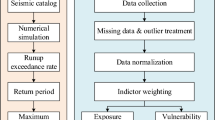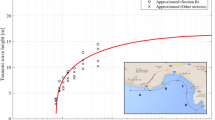Abstract
In this study, we present a novel methodology that may be used to analyze tsunami risk along coastal regions. The application of the proposed methodology is demonstrated for the Eastern Mediterranean coast. Economic, social and environmental dimensions of risk are calculated and aggregated to obtain the overall risk maps for a number of elements at risk (EaR) that are identified from seven countries located along the Eastern Mediterranean coastline. Historical earthquakes that are recorded in the region during the period 1900–2013 are used as data, and probabilistic tsunami modeling is carried out using Monte Carlo analysis. Based on historical data, randomly generated earthquakes are simulated, and wave propagation analysis is performed using NAMI-DANCE software. Inundation depth–damage analysis and exceedance probabilities of tsunami inundations are used to evaluate social and economic risks while the environmental risk is calculated using a binary approach. The overall risk map is constructed in the geographic information system environment. Cairo Agricultural Area in Egypt and Fethiye City in Turkey are identified as high-risk EaR in the Eastern Mediterranean coastline. The new risk assessment methodology may be utilized in coastal regions of the world, and the results obtained for the Eastern Mediterranean may be effectively used in developing preventive measures and disaster management strategies for tsunamis that may develop the region.



















Similar content being viewed by others
References
Abt SR, Wittler RJ, Taylor A (1989) Predicting human instability in flood flows. In: Hydraulic engineering. ASCE, pp 70–76. Available at: https://cedb.asce.org/CEDBsearch/record.jsp?dockey=0062523
Altinok Y, Ersoy Ş (2000) Tsunamis observed on and near the Turkish coast. Natural hazards. Springer, Dordrecht, pp 185–205
Ambraseys N, Synolakis C (2010) Tsunami catalogues for the Eastern Mediterranean. J Earthquake Eng 14(3):309–330
Baytiyeh H, Naja M (2016) The effects of fatalism and denial on earthquake preparedness levels. Disaster Preven Manag 25(2):154–167
Blaser L, Krüger F, Ohrnberger M, Scherbaum F (2010) Scaling relations of earthquake source parameter estimates with special focus on subduction environment. Bull Seismol Soc Am 100(6):2914–2926
Birkmann J, Fernando N (2008) Measuring revealed and emergent vulnerabilities of coastal communities to tsunami in Sri Lanka. Disasters 32(1):82–105
Brooks N, Adger WN, Kelly PM (2005) The determinants of vulnerability and adaptive capacity at the national level and the implications for adaptation. Glob Environ Change 15(2):151–163
Cankaya ZC, Suzen ML, Yalciner AC, Kolat C, Zaytsev A, Aytore B (2016) A new GIS-based tsunami risk evaluation: MeTHuVA METU tsunami human vulnerability assessment at Yenikapı, Istanbul. Earth Planets Space 681:133
Cardona OD, Ordaz MG, Marulanda MC, Carreño ML, Barbat AH (2010) Disaster risk from a macroeconomic perspective: a metric for fiscal vulnerability evaluation. Disasters 344:1064–1083
Carreño ML, Cardona OD, Barbat AH (2007) Urban seismic risk evaluation: a holistic approach. Nat Hazards 401:137–172
CIA (2019) Available online: https://www.cia.gov/library/publications/the-world-factbook/geos/ly.html
Di Giacomo D, Engdahl ER, Storchak DA (2018) The ISC-GEM Earthquake Catalogue (1904–2014): status after the extension project. Earth Syst Sci Data 10:1877–1899. https://doi.org/10.5194/essd-10-1877-2018
DVWK-Deutscher Verband fu¨r Wasserwirtschaft und Kulturbau (1985) Okonomische Methoden von Hochwasserschutzwirkungen. Arbeitsmaterialien zum methodischen Vorgehen. DVWK-Mitteilungen
Eckert S, Jelinek R, Zeug G, Krausmann E (2012) Remote sensing-based assessment of tsunami vulnerability and risk in Alexandria. Egypt Appl Geogr 322:714–723
Endoh K, Takahashi S (1995) Numerically modeling personnel danger on a promenade breakwater due to overtopping waves. Coast Eng 1994:1016–1029
Engdahl ER, Villaseñor A (2002) Global seismicity: 1900–1999. In: Lee WHK, Kanamori H, Jennings PC, Kisslinger C (eds) International handbook of earthquake and engineering seismology part A, Chapter 41. Academic Press, Cambridge, pp 665–690
GDP per capita (2019) Available online: https://data.worldbank.org/indicator/NY.GDP.PCAP.CD
Giardini D (1999) The global seismic hazard assessment program GSHAP-1992/1999. Ann Geophys 426
Giardini D, Woessner J, Danciu L, Crowley H, Cotton F, Grünthal G, Basili R (2013) Seismic hazard harmonization in Europe SHARE. Online data resource. Swiss Seism. Serv ETH Zurich Zurich Switz. Doi, 10. https://www.share-eu.org/
Goda K, Abilova K (2016) Tsunami hazard warning and risk prediction based on inaccurate earthquake source parameters. Nat Hazards Earth Syst Sci 162:577–593
Goda K, Yasuda T, Mori N, Maruyama T (2016) New scaling relationships of earthquake source parameters for stochastic tsunami simulation. Coast Eng J 58(03):1650010
Gouldby B, Samuels P (2005) Language of risk—project definitions. Floodsite Proj Rep T32-04-01.
Hancilar U (2012) Identification of elements at risk for a credible tsunami event for Istanbul. Nat Hazards Earth Syst Sci 121:107
Hanks TC, Kanamori H (1979) A moment-magnitude scale. J Geophys Res 84:2348–2350
Harris EC (2010) International buildings costs worldwide, May 2010. EC Harris Built Asset Consultancy.
Horspool N, Pranantyo I, Griffin J, Latief H, Natawidjaja DH, Kongko W et al (2014) A probabilistic tsunami hazard assessment for Indonesia. Nat Hazards Earth Syst Sci 1411:3105–3122
Huizinga J, de Moel H, Szewczyk W (2017) Global flood depth-damage functions. Methodology and the database with guidelines EUR 28552 EN https://doi.org/10.2760/16510
Jaimes MA, Reinoso E, Ordaz M, Huerta B, Silva R, Mendoza E, Rodríguez JC (2016) A new approach to probabilistic earthquake-induced tsunami risk assessment. Ocean Coast Manag 119:68–75
Jonkman SN, Penning-Rowsell E (2008) Human instability in flood flows. JAWRA J Am Water Resour As 445:1208–1218
Kandilli Observatory and Earthquake Research Institute (KOERI). Available at: https://www.koeri.boun.edu.tr/sismo/2/earthquake-catalog/
Kubal C, Haase D, Meyer V, Scheuer S (2009) Integrated urban flood risk assessment-adapting a multicriteria approach to a city. Nat Hazards Earth Syst Sci 96:1881
Kul S (2014) Istatistik Sonuçlarinin Yorumu: p-degeri ve Güven Araligi Nedir? /interpretation of statistical results: What is p-value and confidence interval? Plevra Bülteni 81:11
Lane EM, Gillibrand PA, Wang X, Power W (2013) A probabilistic tsunami hazard study of the Auckland region. Part II: inundation modelling and hazard assessment. Pure Appl Geophys 1709–10:1635–1646
Løvholt F, Glimsdal S, Harbitz CB, Zamora N, Nadim F, Peduzzi P, Smebye H (2012) Tsunami hazard and exposure on the global scale. Earth Sci Rev 1101–4:58–73
Løvholt F, Glimsdal S, Harbitz CB, Horspool N, Smebye H, De Bono A, Nadim F (2014) Global tsunami hazard and exposure due to large co-seismic slip. Int J Disaster Risk Reduct 10:406–418
Meyer V, Scheuer S, Haase D (2009) A multicriteria approach for flood risk mapping exemplified at the Mulde river, Germany. Nat Hazards 481:17–39
Nadim F, Glade T (2006) On tsunami risk assessment for the west coast of Thailand
Necmioğlu Ö (2014) Tsunami hazard in turkey and surroundings. Doctoral dissertation PhD. Thesis Boğaziçi University Kandilli Observatory and Earthquake Research Institute, Istanbul, Turkey.
Ozel NM, Ocal N, Yalciner AC, Kalafat D, Erdik M (2011) Tsunami hazard in the Eastern Mediterranean and its connected seas: toward a tsunami warning center in Turkey. Soil Dyn Earthq Eng 31(4):598–610
Papadopoulos GA (2000) Tsunamis in the East Mediterranean: a catalog for the area of Greece and adjacent seas. In: Proceedings of the international workshop on tsunami risk assessment beyond (pp 34–42)
Papadopoulos GA, Chalkis BJ (1984) Tsunamis observed in Greece and the surrounding area from antiquity up to the present times. Mar Geol 56(1–4):309–317
Papazachos BC, Scordilis EM, Panagiotopoulos DG, Papazachos CB, Karakaisis GF (2004) Global relations between seismic fault parameters and moment magnitude of earthquakes. Bull Geol Soc Greece 36:1482–1489
Papadopoulos GA, Daskalaki E, Fokaefs A, Giraleas N (2007) Tsunami hazards in the Eastern Mediterranean: strong earthquakes and tsunamis in the East Hellenic Arc and Trench system. Nat Hazards Earth Syst Sci 7(1):57–64
Saleh HA, Allaert G (2014) Disaster management and risk reduction: impacts of sea level rise and other hazards related to tsunamis on Syrian coastal zone. Typhoon impact and crisis management. Springer, Berlin, Heidelberg, pp 481–537
Shenhar G, Radomislensky I, Rozenfeld M, Peleg K (2015) The impact of a national earthquake campaign on public preparedness: 2011 campaign in Israel as a case study. Disaster Med Public Health Prep 92:138–144
Soffer Y, Goldberg A, Adini B, Cohen R, Ben-Ezra M, Palgi Y, Bar-Dayan Y (2011) The relationship between demographic/educational parameters and perceptions, knowledge and earthquake mitigation in Israel. Disasters 351:36–44
Sørensen MB, Spada M, Babeyko A, Wiemer S, Grünthal G (2012) Probabilistic tsunami hazard in the Mediterranean sea. Jf Geophys Res Solid Earth 117(B1)
Soloviev SL, Go CN, Kim KS, Solovieva ON, Shetnikov NA (1997) Tsunamis in the Mediterranean sea 2000 BC-1991 AD. PhD dissertation, Institute of Oceanology, Moscow
SRTM Shuttle Radar Topography Mission (2019) Available online: https://www2.jpl.nasa.gov/srtm/
Storchak DA, Di Giacomo D, Engdahl ER, Harris J, Bondár I, Lee WHK, Bormann P, Villaseñor A (2015) The ISC-GEM Global instrumental earthquake catalogue (1900–2009):introduction. Phys Earth Planet Int 239:48–63. https://doi.org/10.1016/j.pepi.2014.06.009
Strunz G, Post J, Zosseder K, Wegscheider S, Mück M, Riedlinger T et al (2011) Tsunami risk assessment in Indonesia. Nat Hazards Earth Syst Sci 11:67–82
Synolakis CE (1991) Green’s law and the evolution of solitary waves. Phys Fluids A 33:490–491
Temel İstatistikler (2019) Available online: https://www.tuik.gov.tr/UstMenu.do?metod=temelist
TRANSFER (2009) Tsunami risk and strategies for the European region. https://cordis.europa.eu/project/rcn/81399_en.html
Tufekci D, Suzen ML, Yalciner AC, Zaytsev A (2018) Revised MeTHuVA method for assessment of tsunami human vulnerability of Bakirkoy district, Istanbul. Nat Hazards 902:943–974
Wells DL, Coppersmith KJ (1994) New empirical relationships among magnitude, rupture length, rupture width, rupture area, and surface displacement. Bull Seismol Soc Am 844:974–1002
World Health Organization (2012) The great east Japan earthquake: a story of a devastating natural disaster, a tale of human compassion
Yalciner AC, Pelinovsky E, Zaytsev A, Kurkin A, Ozer C, Karakus H (2006) Nami dance manual. Middle East Technical University Civil Engineering Department, Ocean Engineering Research Center, Ankara
Yavuz C (2018) Tsunami risk assessment and positioning of tsunami early warning system. PhD diss., Middle East Technical University, Civil Engineering Department, Ankara, Turkey
Yolsal-Çevikbilen S, Taymaz T (2012) Earthquake source parameters along the Hellenic subduction zone and numerical simulations of historical tsunamis in the Eastern Mediterranean. Tectonophysics 536:61–100
Acknowledgements
This study is prepared from the completed Ph.D. thesis in the Middle East Technical University, Turkey.
Author information
Authors and Affiliations
Corresponding author
Additional information
Publisher's Note
Springer Nature remains neutral with regard to jurisdictional claims in published maps and institutional affiliations.
Rights and permissions
About this article
Cite this article
Yavuz, C., Kentel, E. & Aral, M.M. Tsunami risk assessment: economic, environmental and social dimensions. Nat Hazards 104, 1413–1442 (2020). https://doi.org/10.1007/s11069-020-04226-y
Received:
Accepted:
Published:
Issue Date:
DOI: https://doi.org/10.1007/s11069-020-04226-y




